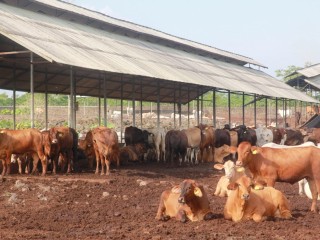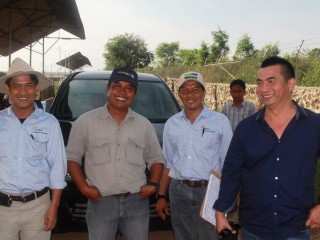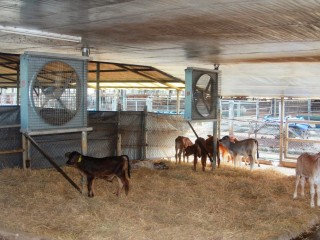 One of the most modern feedlots in Indonesia is used not for fattening cattle, but for breeding them.
One of the most modern feedlots in Indonesia is used not for fattening cattle, but for breeding them.
Santori’s Jabung “breedlot” in eastern Sumatra is Indonesia’s largest cattle breeding operation.
It is a one of a handful of intensive breeding programs developed by importers and lotfeeders in recent times to satisfy the Indonesian Government’s desire to achieve self-sufficiency in local beef production.
Most of the 14.8 million cattle Indonesia claims to have are spread across millions of small landholders who own one to two head each.
Locals argue that Indonesia’s problem with achieving self-sufficiency is not so much whether they have enough local cattle, but rather, with the barriers that exist to converting the local herd into beef as the market requires.
Logistics, distribution, age and quality all work against the local industry’s ability to deliver beef to the market in the exact volumes required when consumers want it.
There are obvious appeals for the Indonesian Government in boosting local cattle production. Reducing its heavy reliance on Australia after it cut off supply without warning last year is undoubtedly high among them.
The potential to save on the estimated $240 per head it costs to ship cattle across from Australia is another.
In line with that aim, Indonesian importers and lot feeders have been offered increasing incentives such as subsidised interest rates in recent years to undertake breeding programs to support the Indonesian Government’s self-sufficiency goal.
Those incentives have been ramped up this year with the introduction of a new import credit system that gives importers/lotfeeders a greater share of existing import permits as a reward for undertaking activities designed to promote local production, such as breeding, feed more local cattle and working with small landholders.
However, while attractive in theory, breeding in volume continues to prove economically-challenging in reality in Indonesia.
With agricultural land generally too expensive to justify large-scale cattle breeding in the traditional, extensive sense, a key focus in recent years has been on exploring whether intensive breeding can work in a feedlot situation instead.
No company has made a bigger commitment to answering that question than Santori, which has developed a 12,000 breeding facility over the past five years, easily the biggest single breeding enterprise in the country.
Santori is the cattle division of publicly-listed Indonesian agrifood company JAPFA, and is a recognised market leader in Indonesia’s beef supply chain. It is one of the country’s biggest importers, lot feeders and abattoir operators and supplies beef both to traditional wet markets and via its own value-added brands to high-end modern supermarkets.
 As the company’s vice president of beef feedlots, Guntur Pribadi, explained, the Jabung breedlot project is truly pioneering work.
As the company’s vice president of beef feedlots, Guntur Pribadi, explained, the Jabung breedlot project is truly pioneering work.
While outside experts have been brought in to provide advice on areas such as genetics and cattle management, ultimately the untried nature of the project has demanded learning from old fashioned trial and error.
“You can’t learn from a book, no one does this,” Guntur explains with a broad grin, hinting to the many challenges that have been encountered over the past five years.
Pioneering project
Santori started with a pilot program involving 50 breeding cattle in 2008, and has grown that significantly since, with around 7300 breeders expected to calve during the current May-July dry season.
Cattle are stocked at a minimum rate of one head to 50 square metres, with the entire facility encompassing 45 individual paddocks. The breedlot has been built on an area of rocky ground well suited to carrying cattle during the wet season and of little value to other types of agriculture.
Lessons learned have resulted in year-on-year improvements, with performance figures last year including a pregnancy rate of 72pc, calving rate of 68pc and weaning rate of 58pc.
Santori is the first to admit that breeding in an intensive environment remains a far from profitable venture, and is currently being subsidised by its imported feeder cattle operations.
The venture has been undertaken to support Indonesian Government policy, and, under the recently introduced import credit system, should also position the company well to win a greater share of future import permits compared to feedlot operators that haven’t adopted breeding programs.
Now in its fifth year, the cost of producing a calf at Jabung is around $500 a head, based largely on the high costs of feeding cattle in a feedlot situation and the impact of high calf mortality rates, which totalled 18pc last year. (By comparison, the cost of putting a calf on the ground in northern Australia where feed is readily available in the form of grass is around $60-$70 a head).
Reducing the calf-mortality rate is the number one focus of the operation.
Calf losses have been blamed largely on the challenging mothering environment and newborn calves failing to feed from their mother, and hence missing out on vital colostrum, within three hours of birth.
In response Santori has established a milking parlour and intensive care facility at Jabung. Three staff constantly monitor calving pens and move any calf that has failed to suckle within three hours with its mother to the intensive facility.
 Calves are bottle fed with their mother’s milk and kept on straw bedding in covered, temperature controlled sheds until they are strong enough to return to the paddocks.
Calves are bottle fed with their mother’s milk and kept on straw bedding in covered, temperature controlled sheds until they are strong enough to return to the paddocks.
Calf mortality rates have also been higher in paddocks where calving has occurred during wetter months, so management has also moved to synchronise mating in order to confine calving to the three month May-July dry season.
Females are grouped according to their stage in the breeding cycle and fed rations tailored to their specific needs.
A shift towards superior genetics through the importation of composite breeders from Australia is also underway in order to improve fertility and ultimately weaning rates.
Both natural matings and AI have been used in the past, with pregnancy rates of 72-74pc from natural and 80pc from AI recorded. Natural matings have previously involved a mix of imported bulls and some bulls bred within its own breeding program. Santori is now shifting to using imported bulls well adapted to northern Australia’s rugged environment to better cover the rocky, contoured ground in the Jabung facility, which it believes should also help to further improve pregnancy rates.
The company is also focusing on ways to lower overall feed costs per head to boost the economic viability of the enterprise, with less expensive sources of fibre such as rice straw and king grass being trialled in place of the standard ration of corn silage in some pens this year.
With the high costs of producing cattle in a breedlot situation, Santori believes the future of the concept is likely to lie in feeding higher value cattle such as Wagyu and composites.
Palm pilot
While breeding in a feedlot environment is proving practically viable, if not yet financially viable, many are looking at the vast hectares of palm oil plantations in Indonesia as a likely source of large scale breeding land.
More than 10 million hectares of otherwise underutilised land is currently under palm oil plantations in Indonesia. Adding to the attraction is the fact that palm fronds also serve as a potential source of fibre for breeding cattle.
Santori is set to commence a 1200 head pilot project with a palm oil company in coming months to assess the viability in integrating cattle breeding with palm plantations.
Breeding has been trialled under palms in Indonesia before to limited success, but never with the benefit of local breeding knowledge that companies like Santori have acquired through their intensive breeding programs over the past five years.
"It is not easy, but there is good potential," Guntur Pribadi said.
